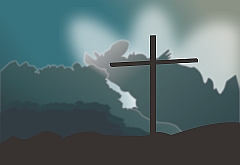
The gospels give us the narrative of the crucifixion and resurrection of Jesus by those closest to Jesus.
John the apostle was standing at the foot of the cross of Jesus, together with Mary and others. Jesus Himself addressed this apostle from the cross to ask him to take care of His mother. (see John 19:27)
“Near the cross of Jesus stood His mother and her sister, as well as Mary the wife of Clopas and Mary Magdalene.” John 19:25
[Jesus said]… to the disciple, “Here is your mother.” From that time on, this disciple took her into his home. John 19:27
There were many others as well who were witnesses on that day.
And all the crowds that had assembled for this spectacle, when they saw what had taken place, returned home beating their breasts. And all his acquaintances and the women who had followed him from Galilee stood at a distance watching these things.
Luke 23:48-49 ; Mark 15:40
And there were also women watching from a distance. Among them were Mary Magdalene, Mary the mother of James the younger and of Joseph, and Salome.
What about the verse that says, “They all left him fled.” (Mark 14:50)?
Muslims have been taught this verse but their teachers failed to tell them what happened next. The disciples fled on the night of Jesus’ arrest, not at the crucifixion. In fact, just a few verses after the “fleeing”, it says “Peter followed Him at a distance, right into the courtyard of the high priest. ” (Mark 14:54). So it is NOT true that they all fled and disappeared forever. They fled AT THE TIME of the arrest to avoid being arrested themselves but they remained nearby. As shown earlier, John the apostle was right at the cross during the crucifixion the next day.
The gospels present the most reliable and trustworthy eyewitness accounts of the crucifixion and resurrection of Jesus.
However, skeptics point to the various differences in these narratives as evidence that it must be false. Questions like: Were there one angel or two? How many women…? and so on.
In actual fact these are not contradictions. These are differences. We have to remember that none of the gospel writers claimed they were giving the exact chronological order or even all the details. A witness can differ with another witness and not contradict each other.
For example: If I witness a bank robbery and I tell the police, “I saw three men in a car outside the bank,” and then another witness says that she saw a man with a gun in the car. Our testimonies are different. Does it mean we have contradicted each other? No. Our perspectives were different. The other witness did not say there was ONLY one man in the car. Her perspective was the man with the gun. If she had said there was ONLY one man in the car and I said there were three, THEN it would be a contradiction.
The gospel accounts of the resurrection and post-resurrection appearances can be harmonized in chronological order without any contradictions.
1. Jesus is buried, as several women watch (Matthew 27:57-61; Mark 15:42-47; Luke 23:50-56; John 19:38-42).
2. The tomb is sealed and a guard is set (Matthew 27:62-66).
3. At least 3 women, including Mary Magdalene, Mary the mother of James, and Salome, prepare spices to go to the tomb (Matthew 28:1; Mark 16:1).
4. An angel descends from heaven, rolls the stone away, and sits on it. There is an earthquake, and the guards faint (Matthew 28:2-4).
5. The women arrive at the tomb and find it empty. Mary Magdalene leaves the other women there and runs to tell the disciples (John 20:1-2).
6. The women still at the tomb see two angels who tell them that Jesus is risen and who instruct them to tell the disciples to go to Galilee (Matthew 28:5-7; Mark 16:2-8; Luke 24:1-8).
7. The women leave to bring the news to the disciples (Matthew 28:8).
8. The guards, having roused themselves, report the empty tomb to the authorities, who bribe the guards to say the body was stolen (Matthew 28:11-15).
9. Mary the mother of James and the other women, on their way to find the disciples, see Jesus (Matthew 28:9-10).
10. The women relate what they have seen and heard to the disciples (Luke 24:9-11).
11. Peter and John run to the tomb, see that it is empty, and find the grave clothes (Luke 24:12; John 20:2-10).
12. Mary Magdalene returns to the tomb. She sees the angels, and then she sees Jesus (John 20:11-18).
13. Later the same day, Jesus appears to Peter (Luke 24:34; 1 Corinthians 15:5).
14. Still on the same day, Jesus appears to Cleopas and another disciple on their way to Emmaus (Luke 24:13-32).
15. That evening, the two disciples report the event to the Eleven in Jerusalem (Luke 24:32-35).
16. Jesus appears to ten disciples—Thomas is missing (Luke 24:36-43; John 20:19-25).
17. Jesus appears to all eleven disciples—Thomas included (John 20:26-31).
18. Jesus appears to seven disciples by the Sea of Galilee (John 21:1-25).
19. Jesus appears to about 500 disciples in Galilee (1 Corinthians 15:6).
20. Jesus appears to His half-brother James (1 Corinthians 15:7).
21. Jesus commissions His disciples (Matthew 28:16-20).
22. Jesus teaches His disciples the Scriptures and promises to send the Holy Spirit (Luke 24:44-49; Acts 1:4-5).
23. Jesus ascends into heaven (Luke 24:50-53; Acts 1:6-12).
No contradiction.

Harmony of gospel accounts adapted from GotQuestions